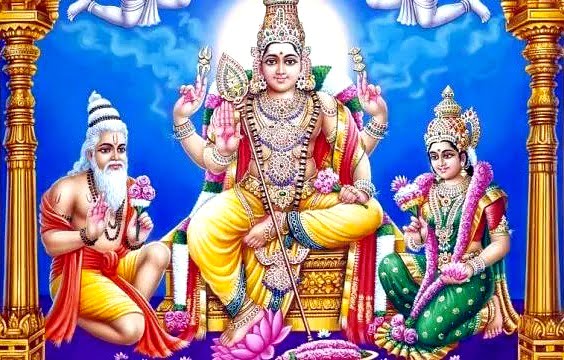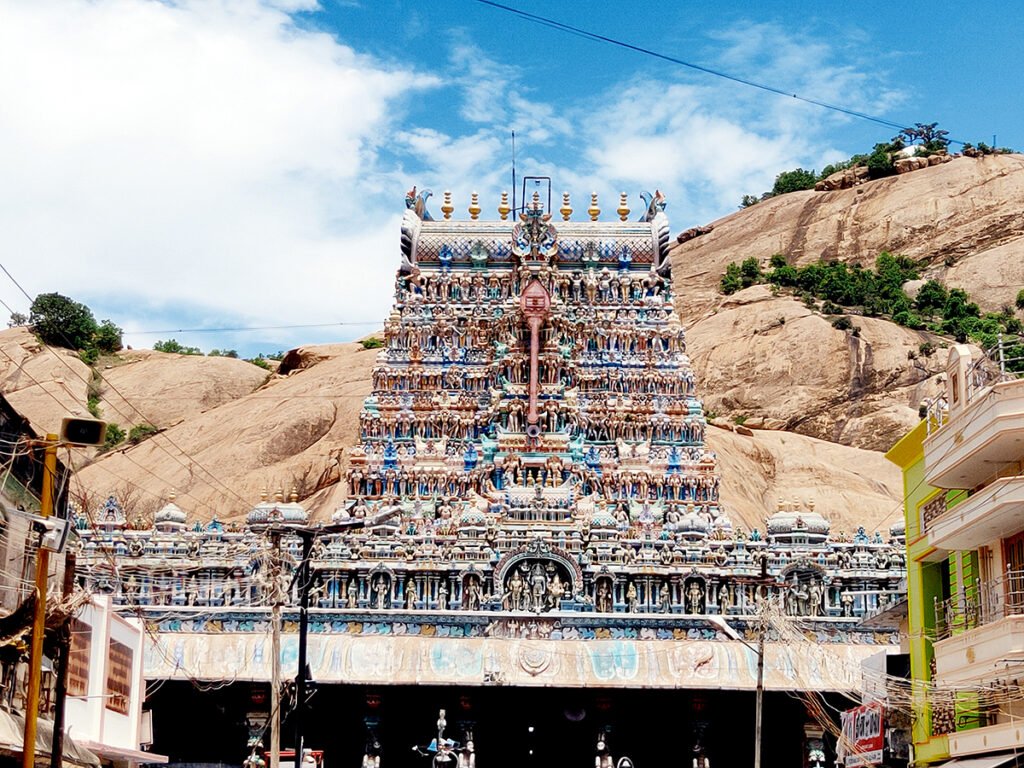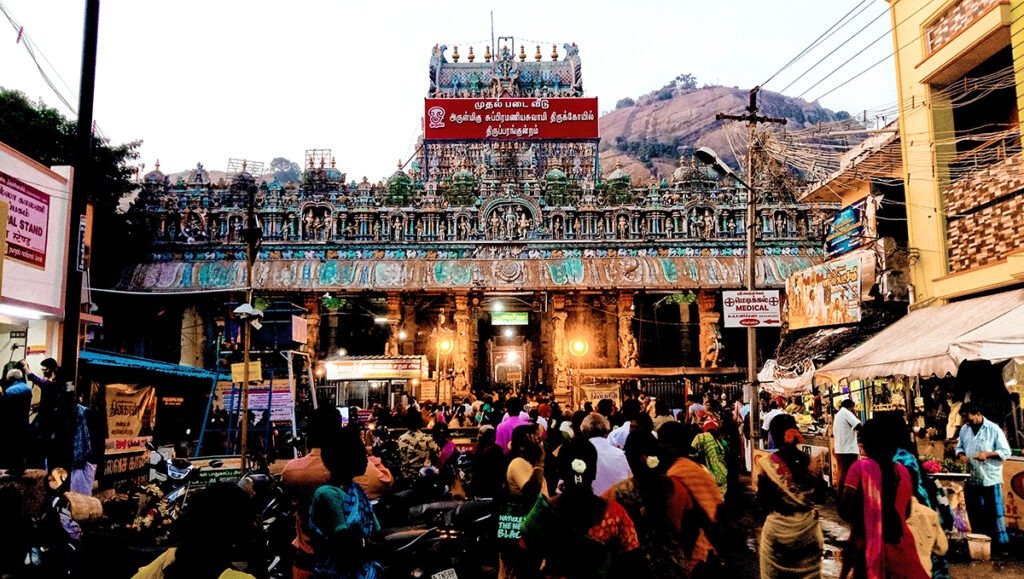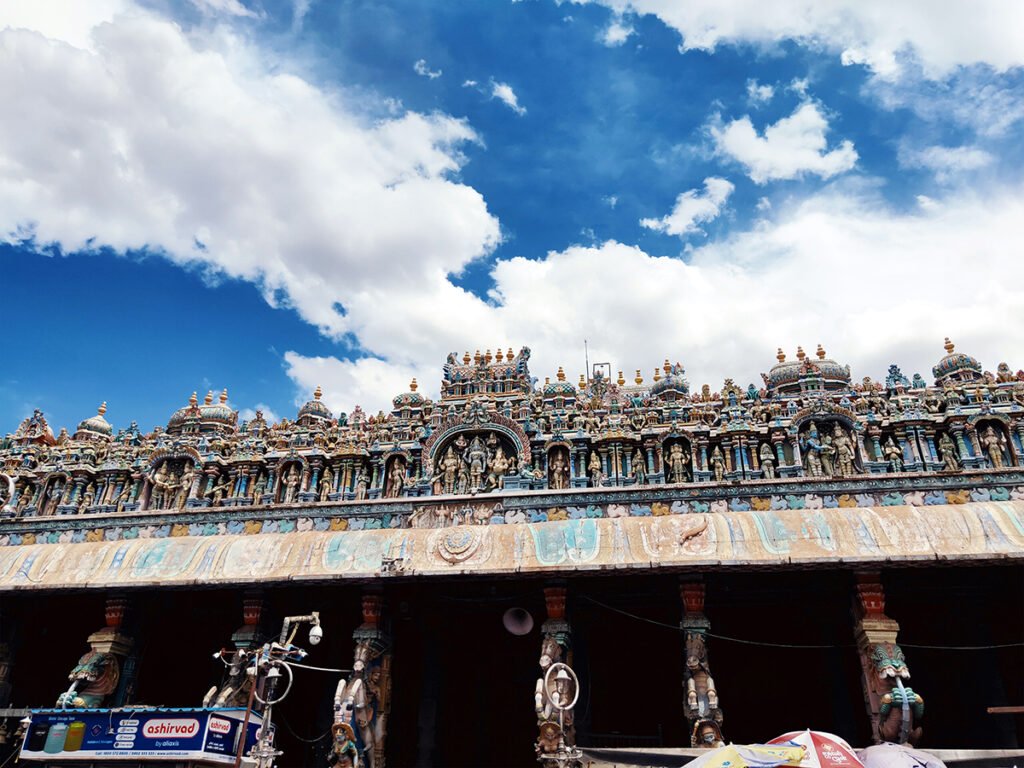Subramanya Swamy Temple Thiruparankunram
Subramanya Swamy Temple Thiruparankunram is a Hindu shrine located in the city of Madurai, Tamil Nadu, India. It is dedicated to Lord Subramanya, also known as Kartikeya or Murugan, who is considered the Hindu god of war and victory.

Thiruparankunram is one of the six holy abodes of Lord Murugan, known as Arupadaiveedu. The shrine is situated on a hill called Thiruparankunram, which is about 8 kilometers southwest of Madurai. It is believed to be one of the oldest temples in Tamil Nadu and has historical and religious significance.
The shrine is unique because it is carved out of a rock hill. It has multiple layers and is considered an architectural marvel. The main deity of the temple is Lord Subramanya, who is depicted with six faces and twelve hands, holding various weapons. The presiding deity is worshipped as “Lord Subramanya with Valli and Devasena” and is believed to be in a wedding posture.
The shrine attracts a large number of devotees throughout the year, especially during the festival of Skanda Sashti, which is dedicated to Lord Subramanya. During this festival, various rituals and processions take place, and devotees participate in elaborate ceremonies and offer their prayers.
Apart from the main deity, the temple also houses shrines dedicated to other deities such as Lord Shiva, Goddess Parvati, Lord Vinayaka (Ganesha), and Goddess Durga. The shrine complex also includes several smaller shrines, pillared halls, and a sacred tank.
Visiting the Subramanya Swamy Temple at Thiruparankunram provides a spiritual experience and an opportunity to admire the ancient architecture of the shrine. It is an important pilgrimage site for devotees of Lord Murugan and a significant historical and cultural landmark in the region.
Contents
Story of Subramanya Swamy Temple Thiruparankunram:
The story of Subramanya Swamy Temple Thiruparankunram is rooted in Hindu mythology and revolves around Lord Murugan, also known as Kartikeya or Subramanya. According to the legend, the temple’s origin is associated with a great battle between the gods and the demons.
Once, the demon king Surapadman gained immense power and began tormenting the gods and sages. In desperation, the gods sought the help of Lord Shiva and Goddess Parvati. In response to their prayers, Lord Murugan was born as the divine child of Lord Shiva and Goddess Parvati, with six faces and twelve arms.
As Lord Murugan grew up, he was informed about his divine mission to defeat Surapadman and restore peace. He embarked on a fierce battle against the demons, who were led by Surapadman. The battle raged on for days, with neither side gaining an advantage.
Finally, in the decisive moment of the battle, Lord Murugan split Surapadman into two halves using his divine spear, known as Vel. The two halves transformed into a peacock and a rooster, which became Lord Murugan’s divine mounts.
Following his victory, Lord Murugan decided to settle down at Thiruparankundram, a place that was spiritually charged and ideal for furthering his divine mission. It is said that Lord Murugan married the divine princesses Valli and Devasena in Thiruparankundram, and the temple is seen as a representation of their divine wedding.
The Thiruparankundram Murugan Temple was constructed as a sacred abode for Lord Murugan. The temple’s unique feature is that it is built on a hill, with various levels and intricate rock carvings. The sanctum sanctorum of the shrine houses the main deity, Lord Murugan, in his six-faced form, along with his consorts Valli and Devasena.
The temple has witnessed various historical events and undergone renovations and expansions over the centuries. It continues to be a place of worship and pilgrimage, attracting devotees from far and wide.
The story of Thiruparankundram Murugan Temple signifies the triumph of good over evil and serves as an inspiration for devotees seeking protection, victory, and spiritual blessings from Lord Murugan. It remains an important religious and cultural landmark, deeply revered by devotees of Lord Murugan in Tamil Nadu and beyond.

Temple Architecture:
The architecture of the Thiruparankundram Murugan Temple is a unique blend of rock-cut and structural styles, reflecting the ancient Dravidian architectural traditions. The shrine is carved out of a massive rock hill, which adds to its architectural grandeur and significance. Here are some key features of its architecture:
Rock-cut Mandapams: This holy place has several mandapams (pillared halls) carved out of the rock, creating a natural ambience. These mandapams serve as assembly and resting areas for devotees. The pillars in these halls are adorned with intricate carvings depicting various mythological scenes and deities.
Gopurams (Gateways): The shrine has several gopurams or towering gateways that mark the entrance to the temple complex. These gopurams are typically adorned with ornate sculptures, depicting gods, goddesses, celestial beings, and mythological narratives. The gopurams are constructed in the Dravidian style, characterized by multiple tiers and elaborate detailing.
Main Sanctum: The main sanctum or garbhagriha houses the deity of Lord Subramanya with Valli and Devasena. The sanctum is located deep inside the rock and is accessed through a narrow passage. The sanctum enshrines the idol of Lord Subramanya with six faces and twelve hands, holding various weapons.
Vimana: The vimana is the tower-like structure above the main sanctum, also known as the tower of the main shrine. It is constructed in the Dravidian style and features intricate sculptures and carvings. The vimana is adorned with colorful paintings depicting scenes from Hindu mythology.
Subsidiary Shrines: Subramanya Swamy Temple Thiruparankunram complex also includes several subsidiary shrines dedicated to other deities such as Lord Shiva, Goddess Parvati, Lord Vinayaka (Ganesha), and Goddess Durga. These shrines follow a similar architectural style with unique carvings and sculptures specific to each deity.
Sacred Tank: This holy place has a sacred tank or a pushkarini called “Siddhamirtham.” Devotees take ritual baths in this tank, which is believed to have purifying properties. The tank adds to the overall aesthetic appeal of the temple complex.

Marriages in the temple premises:
Couples who wish to get married at the Thiruparankunram Murugan Temple need to make prior arrangements and obtain permission from the kovel authorities. Here are some important details and steps involved:
Prior booking: The couple or their families need to contact the temple administration well in advance to check for availability and make the necessary arrangements. It is advisable to book the desired date and time for the wedding ceremony.
Documentation: The couple needs to provide relevant documents for the marriage, such as birth certificates, identification proofs, and photographs. It is recommended to inquire about the specific documents required from the Subramanya Swamy Temple Thiruparankunram administration.
Rituals and procedures: The wedding ceremony at the Thiruparankunram Murugan Temple generally follows traditional Hindu customs and rituals. The temple priests guide the couple through the procedures, which include the exchange of garlands, tying of the sacred thread (mangalsutra), and taking the sacred vows.
Offering prayers: Before and after the wedding ceremony, the couple and their families can offer prayers and seek blessings from Lord Murugan and the other deities present in the shrine.
Witness and guests: This holy place may have certain restrictions on the number of guests or witnesses allowed during the ceremony. It is advisable to inquire about these details while making the arrangements.
Temple Timing:
Morning Timings:
Subramanya Swamy Temple Thiruparankunram opens early in the morning, usually around 5:00 AM.
The morning darshan (viewing of the deity) and rituals take place from 5:00 AM to 12:00 PM.
Afternoon Break:
There is an afternoon break or temple closure between 12:00 PM and 4:00 PM. During this time, the temple remains closed to devotees.
Evening Timings:
The temple reopens in the evening at around 4:00 PM.
The evening darshan and rituals continue from 4:00 PM until the temple closes.
Closing Time:
The shrine generally closes at around 9:00 PM in the evening.
It’s important to note that these timings are subject to change, and it’s recommended to check the updated timings before planning your visit. You can contact the Subramanya Swamy Temple Thiruparankunram authorities or check their official website or local sources for the most accurate and up-to-date information regarding the timing of the Thiruparankundram Murugan Temple.

Here are some nearby places you might consider exploring:
Madurai Meenakshi Amman Temple: One of the most famous and significant temples in Madurai, the Meenakshi Amman Temple is dedicated to Goddess Meenakshi (Parvati) and Lord Sundareswarar (Shiva). It is known for its magnificent architecture, intricate carvings, and vibrant temple festivals.
Thirumalai Nayakkar Mahal: Located in Madurai, Thirumalai Nayakkar Mahal is a magnificent palace built in the 17th century. It showcases the architectural brilliance of the Nayak dynasty and features a blend of Dravidian and Islamic styles.
Gandhi Memorial Museum: Situated in Madurai, the Gandhi Memorial Museum is a tribute to Mahatma Gandhi. It displays a vast collection of photographs, artifacts, and memorabilia related to Gandhi’s life and the Indian independence movement.
Koodal Azhagar Temple: Located in the heart of Madurai, Koodal Azhagar Temple is dedicated to Lord Vishnu. The temple is known for its impressive architecture and beautiful sculptures.
Pazhamudircholai Murugan Temple: Situated atop a hill near Madurai, Pazhamudircholai Murugan Temple is another important temple dedicated to Lord Murugan. It is part of the six sacred abodes of Murugan and is surrounded by lush greenery.
Vandiyur Mariamman Teppakulam: It is a large temple tank located in Vandiyur, near Madurai. The tank is known for its annual float festival, where the deities of Meenakshi and Sundareswarar are taken on a grand procession on a decorated float.
Samanar Hills: Located about 15 kilometers from Madurai, Samanar Hills is a historic site with Jain cave temples and rock-cut sculptures. It is a serene place with a beautiful view of the surrounding landscape.
You may also like to check other temples:
Kanipakam Varasiddhi Vinayaka Swamy,
Tirumala Tirupati Venkateswara Swamy,
Twelve Sacred Jyotirlingas of Lord Shiva and
List of 51 Shakti Peethas and their location.
How to reach Temple:
By Air:
The nearest airport is Madurai International Airport, which is well-connected to major cities in India. From the airport, you can hire a taxi or take a local bus to reach Subramanya Swamy Temple Thiruparankunram.
By Train:
Madurai Junction is the nearest major railway station, which is well-connected to various cities in India. From the railway station, you can hire a taxi, auto-rickshaw, or take a local bus to reach the temple.
By Road:
Thiruparankundram is well-connected by road, and you can reach the temple by private vehicle, taxi, or bus. Madurai is well-connected to major cities in Tamil Nadu and neighboring states through a network of highways.
Local Transport:
Once you reach Thiruparankundram, you can hire a local auto-rickshaw or taxi to reach the temple. They are readily available near the bus stand or railway station.
